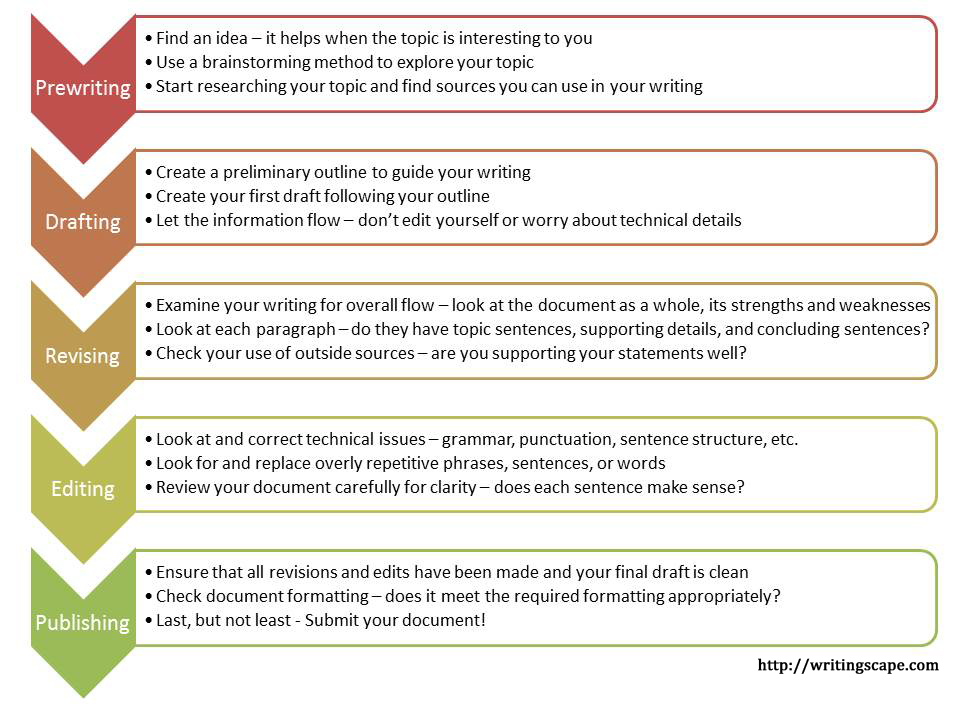The 5-Step Writing Process – Prewriting, Drafting, Revising, Editing, and Publishing
For most people, writing is a point of anxiety. It is hard to get started, let alone to finish, and it’s easy to get lost along the way. Many great writers simply don’t know how to get started! This is why the 5-Step Writing Process is a great checklist for you as you start writing. The Writing Process is: Pre-Writing, Drafting, Revising, Editing, and Publishing.

The 5-Step Writing Process
Pre-Writing
Pre-writing is the “before” you start part of writing. Whether you are writing a blog post, email, essay, short story, or article, you need to start with pre-writing. In the pre-writing process, you are going to identify your topic, use a brainstorming method to consider how you will explore that topic, and complete some preliminary research – make sure to keep track of the sources you do find for later use! A topic that you relate to is helpful, but not always possible.
Drafting
In the drafting process, you will want to get started with the act of writing. I always suggest starting with an outline, even if it is an informal outline. A formal outline is one that uses a scaffolded numerical outline, but an informal outline can simply be a list of topics you plan to cover that identifies where you plan to cover them.
In drafting, you will want to let the information flow. Follow your outline as best as you can, but do not be judgmental of yourself. Let the information flow out onto the document without worrying about syntax, grammar, or even spelling! The important part is getting that information onto the page. You can always come back later to clean it up. This is also an excellent time to refer back to those sources you found in the pre-writing stage so that you can incorporate them into the rough draft.
Revising
There is often a misconception between revising and editing, but they are fundamentally different. I find it best to start with revising. In the revising phase, you will be examining your writing for the overall flow of your words – does your document start in a logical place, progress in a way that makes sense to your reader, and include a conclusion of some kind?
Look at each paragraph – does each paragraph contain a topic sentence, several supporting details or sentences that cover this topic, and a concluding sentence that helps to sum up the paragraph and transition the reader to the next paragraph? Make sure each paragraph does not attempt to cover too much information, or too little. A good paragraph is between 5 and 7 sentences long and focuses on one specific topic. If you find a topic change in the middle of a paragraph, it’s probably a good idea to start a new paragraph.
This is also a good phase to recheck your use of outside sources. Make sure you are supporting your statements with data or information as is needed. This will strengthen the power of what you are trying to say to your reader. Remember, revising is looking at these “big picture” items – not little things like the placement of a comma or how to spell a specific word.
Editing
Editing can be tough, and it may help to seek out professional help if you struggle in this department. While grammar checkers and spell checkers in word processing software is helpful, they are not always accurate and lack the comprehension of a “human mind” to catch certain kinds of errors. In this phase of your writing, you will be looking at these small technical items – such as spelling, grammar, punctuation, and sentence structure. Consulting a grammar guide as needed for this phase can also be helpful.
In addition to these technical errors, you will also want to identify points of repetitiveness and make sure your writing is clear and understandable. Make sure that you do not repeat the same phrases or words too frequently or that you do not start your sentences with the same wording or phrasing too often. You will also want to make sure you are clearly expressing yourself to your reader
Publishing
While this step might often be skipped over, it is the most important aspect to writing – getting your writing out there to whomever needs to see it. Whether this means sending that work memo out by email or publishing a book, your work simply isn’t complete until it fulfills its purpose.
Before you hit “submit” with your document, make sure you have completed all of the revisions and edits you identified in the previous two phases. Make sure your text is clean, clear, and easy to read. Adjust your document to fulfill any required formatting changes, such as including a title page where needed or put all lines of text in double spacing.
And that’s it! It isn’t as hard as it may seem. Once you get started, you can follow these steps and eventually complete your goals. Keep in mind, you may end up revisiting previous phases – maybe you made a major change in the editing phase and now you need to go back to revising to check the “flow” of the paper, or maybe your drafting phase showed you that your topic isn’t good and you need to revisit the pre-writing phase.
